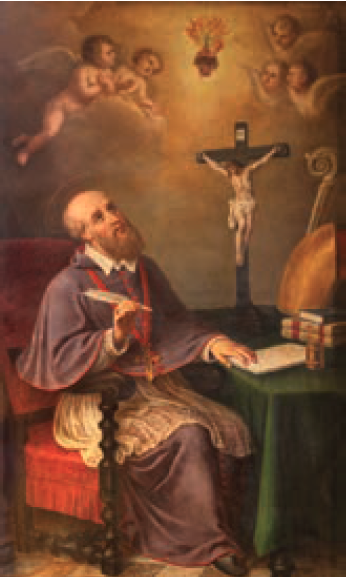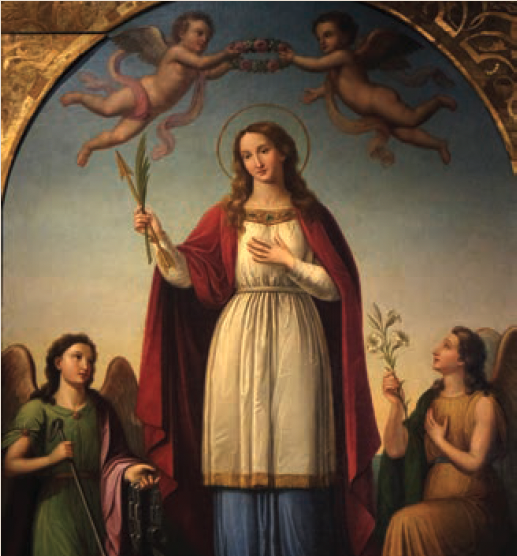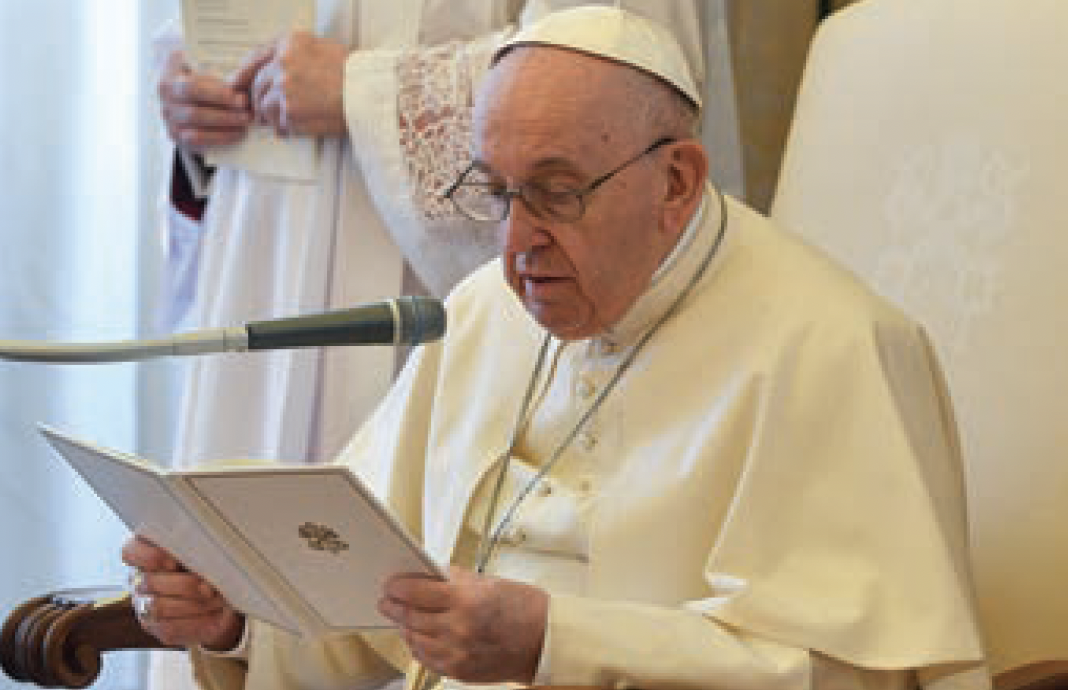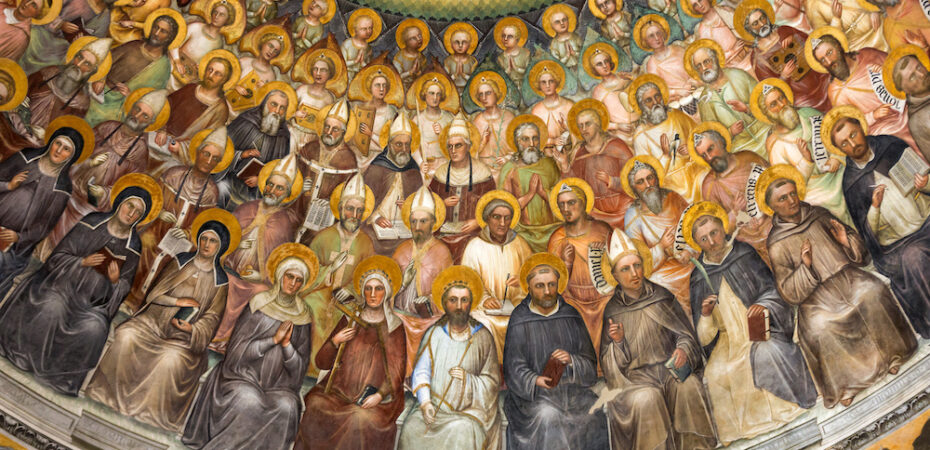Called to Be Saints
How the Church bestows this greatest honor
D.D. Emmons Comments Off on Called to Be Saints
“How little is required to be a saint! It suffices to do in all things the will of God.” — St. Vincent de Paul
Naming someone a saint is the greatest honor the Catholic Church can bestow. Given that honor, one would expect that the process used to make such a momentous determination, called canonization, would be extensive, and so it is; in fact, some would say, extensive, exhaustive and expensive.
The discernment of someone recommended for sainthood can take years of investigation including interviews, document preparation, review of written materials, examinations by tribunals and committees both at the diocesan and Vatican levels, plus at least two miracles have to be attributed to the person under consideration. There is also a five-year wait time after the individual has died prior to a cause being opened. Some causes have been initiated, but the process stymied for centuries. And the effort is costly; the combined investigative phase, as well as the beatification and canonization ceremonies, can average $250,000, according to an OSV News report from May 2, 2023, and sometimes more. Volumes have been written about the methodology for selecting a saint, but perhaps comprehending the details of the selection method is less important than appreciating the merits of the individual saints.
Knowing the Saints
Not all the faithful are well-versed on the saints. It’s not as if there is a lack of information; there are thousands of books and periodicals available. But what is often missing is the frequent messaging from parish leadership that extol the virtues and recognize the sanctity of these holy people. Parish programs studying the lives of the saints can be sources of inspiration and can explain how important saints are to Catholic life. They are our heroes, set apart for us to not only admire but more importantly to imitate. By getting to know the saints, we discover that holiness, while difficult, is not beyond our reach. Certain saints are highlighted as “Eucharistic saints” and reflections on these individuals especially fit this time of the National Eucharistic Revival.

Santa Maria in Montesanto by Raffaele Spano (1817-63). AdobeStock
St. Francis de Sales, in his “Introduction to the Devout Life” suggests that we should read about the saints every day, “just as you were reading a letter that the saints had sent you from heaven to show you the way and give you the courage to go there. … You should also read stories and lives of the saints, for there, as in a mirror, you can see a picture of the Christian life and adapt their deeds to your use in keeping with your vocation.”
Not unlike Catholic beliefs regarding the sacraments, the Blessed Mother, purgatory and indulgences, the saints are essential to all we hold dear. These beliefs, and more, propel us toward the Gospel — not away, as some suggest. Our love and veneration for the saints never conflict with our love and worship of God. It’s from the footstool of Jesus that the saints will intercede on our behalf through the merits of our Savior. They will intercede for us — what a comforting and uplifting belief. Our connection to them is magnified through the Communion of Saints — that is, saints in heaven, saints on earth (all of us) and the saints in purgatory. St. Jerome wrote in Contra Vigilantium (“Against Vigilantius”) that if the saints prayed for us while they were still alive and “solicitous about themselves, how much more will they do so after [receiving] their crowns, victories and triumph?”
Their Virtues
What is a saint? “One whose holiness of life and heroic virtue have been confirmed and recognized by the Church’s official process of beatification and canonization or by the continued existence of an approved cultus and feast,” according to “The Catholic Encyclopedia Dictionary” (The MacMillan Company).
Another definition is a soul spending eternity in heaven, in the presence of God. There are an estimated 10,000 saints named by the Catholic Church and, of course, that number is only a small percentage of the holy people in heaven. Of those officially acknowledged by the Church, about one-third have been named to sainthood through a standardized process. Non-Catholics tend to reject how we regard and venerate the saints.
……………………………………………………………………………………………………………………………………………..
Conversion Story — Lives of the Saints
There is an often-told story, albeit with different versions, about Blessed John Colombini (d. 1367) who, arriving home from work, was angry with his wife because his dinner wasn’t ready. He said he wanted to eat and then return to work so he could count his money.
His wife told him that he made too much money and gave too little away. She handed him a book on the lives of the saints to read while waiting for dinner. He threw the book across the room in disinterest. Eventually, he picked it up and began to read about St. Mary of Egypt. So engrossed did he become that he forgot about dinner and spent the rest of the evening reading and was profoundly touched by the miracle and conversion story associated with St. Mary.
He never went back to count his money. From that time, John opened his heart to God and uncharacteristically began to give money and personal goods to the poor — his charity became legendary both inside and outside his community. He later established a religious order and died in 1367. During the reign of Pope Gregory XIII (1572-85), John Colombini was added as blessed to the Roman martyrology. Grace had touched John in an overwhelming way through the life of a saint.
……………………………………………………………………………………………………………………………………………..
If the secular world honors men and women in all sorts of occupations and circumstances, raises statues in their memory, enshrines them in numerous halls and walls of fame, remembers them in movies and TV specials, why shouldn’t the Catholic Church honor holy and pious men and women? A measuring rod used by the Church to determine the sanctity of someone being considered for canonization is their practice of the theological virtues (faith, hope and charity) and cardinal virtues: prudence, justice, fortitude and temperance. All Christians are called to practice these virtues, but the prospective saint, seeking Christ’s perfection, practiced them in an extraordinary or heroic manner. St. Teresa of Ávila, in “The Interior Castle,” tells us, “If you do not strive for virtues and practice them, you will be dwarfs.”
The saints do not constitute an exclusive club with restricted membership. On the contrary, we are all meant to be part of the club and those already enshrined are excited about guiding us through the admissions process. They are beacons shining out from the shore, helping us navigate toward our heavenly home.
………………………………………………………………………………………………………………………………………………
Once a Saint …
During the 1960s, several saints were suppressed from the liturgical calendar. Such action was based largely on the fact that they were not universally known or there was little evidence that some ever lived. A prime example of the many suppressed is St. Philomena.

Philomena, called virgin and martyr, was afforded every honor of a canonized saint, but she was never officially canonized or added to the official list of saints; no factual evidence of her life was identified. There were numerous reports of miracles attributed to her intercession, Blessed Pauline-Marie Jaricot being the most well-known. Philomena was (and is) greatly esteemed by Catholics everywhere, including popes and future saints; schools, churches, individuals bear her name. Her relics were sent around the world and, as late as the 1990s, sent to the United States.
When her name was removed from the liturgical calendar, many churches were in a quandary, and thousands of Catholics didn’t know what to do. Should their church be renamed? Will she no longer intercede for the faithful? Pope Paul VI responded, “Continue as before and do not upset your people.” Her popular cult was not suppressed; once a saint, always a saint. A votive Mass can be said for St. Philomena.
……………………………………………………………………………………………………………………………………………….
Like all of us, each saint had free will; they could choose heaven or hell, good or evil, saints or not. All were sinners at some point in their lives, even villains and worse — Dismas (the good thief), Saul (persecutor), Olga of Kiev (mass murderer), Longinus (stuck his spear into the side of the crucified Jesus.) They come from all walks and conditions of life — peasants like Joan of Arc, royalty like St. Elizabeth of Hungary, beggars like St. Lazarus, popes like Pope St. John Paul II. And if we choose to become a saint, there are thousands of examples of how we can achieve that goal. “God desires us to follow the example of the saints by absorbing the vital sap of their virtue and turning it into our own life blood, adapting it as our own” (“Journal of a Soul: Autobiography of Pope John XXIII,” McGraw-Hill).
Evolution of Saint-Making
For the first 1,000 years of Christianity, there was no universal criteria, no standardized process of how a saint was selected. Until the fourth century, those regarded as saints were the martyrs (witnesses), Christians who refused to deny Christ in favor of a Roman god or Roman emperor. They poured out their blood for the glory of God. Thousands were put to death and became for other Christians the holiest men and women and were certainly considered in heaven because of their courageous actions. These holy people were given special burials, and were honored on the anniversary of the day they died and remembered in the prayers of the faithful remaining.
In addition to the martyrs, there were the confessors, individuals who also refused to deny Christ but, often for reasons unknown, were not put to death for their beliefs. They, too, were regarded as saints by followers of Christ. When the persecutions ended, the faithful living still singled out individuals who upon death were called holy or saints. Every village had its own saints, many of which were named as such, based on popularity. As the centuries went by, the numbers of local saints reached into the thousands. Bishops had some input, but it was not until 933 when, for the first time, the papacy got involved in identifying men and women worthy to be called saints.
In 1234, Pope Gregory IX (r. 1227-41) reserved to himself the authority to identify someone as a saint, but it wasn’t until 1588 that the Vatican Congregation of Rites was created and established the standards for selecting individuals for sainthood, beginning the process of canonization. These standards served the Church until the 18th century when Pope Benedict XIV (r. 1740-58) issued an extensive work, “Beatification of the Servants of God and their Canonization,” which formalized the detailed norms of canonization.
…………………………………………………………………………………………………………………………………………..
Collect for All Saints Day
Almighty ever-living God, / by whose gift we venerate in one celebration / the merits of all the Saints, / bestow on us, we pray, / through the prayers of so many intercessors, / an abundance of the reconciliation with you / for which we earnestly long.
…………………………………………………………………………………………………………………………………………..
The saint selection practices created by Pope Benedict XIV, weighty and rigorous in application, were largely in place into the 20th century. In 1983, Pope St. John Paul II (r. 1978-2005) made sweeping changes with his apostolic constitution Divinus Pefectionis Magister. This document reduced from 50 years to 5 years the time a candidate had to be deceased before the cause could be initiated; the number of miracles attributed to the sait was changed from four to two; greatly reduced the Vatican double-checking of the documents created and submitted by the diocese; eliminated the age-old arguments between the promoter of faith and the “devil’s advocate” at the Vatican who in a courtroom-style arrangement extensively debated the merits and demerits of the candidate. While these changes and others were welcomed, and simplified the process, they did not eliminate the purposeful examination, the careful scrutiny that rightly accompanies every cause for canonization.
Stages of Canonization
“By canonizing some of the faithful, i.e., by solemnly proclaiming that they practiced heroic virtue and lived in fidelity to God’s grace, the Church recognizes the power of the Spirit of holiness within her and sustains the hope of believers by proposing the saints to them as models and intercessors” (Catechism of the Catholic Church, No. 828).
The word “canon” means a list — that is, to be added to the list. Canonization means to declare someone as worthy of public veneration. In the Catholic Church, canonization defines the process of elevating a person to sainthood, a process broken into three parts — venerable, blessed and saint.
It begins with a petitioner coming to the local bishop (a bishop can be the petitioner) or to the leader of a religious organization with evidence of a person whose life was so steeped in holiness that they are worthy of consideration for sainthood. If the bishop is convinced of the person’s worthiness, he can make further inquiries to determine if there is cause for canonization. No action is taken until after the candidate has been deceased for at least five years, a requirement that the pope can waive.
Before the bishop proceeds, he notifies the Vatican and other local bishops to determine if they have some issue that could impinge on the process. If all goes well, the person can be declared a Servant of God and a diocesan level investigation is begun into the candidate’s life.
At the diocese, a person known as a postulator is assigned to oversee the collection of evidence about the candidate, which includes interviews with people who knew the person, as well as examination of personal papers and writings to determine if the person had any views contrary to the Catholic Church or Christian values. The postulator stays with the process until conclusion. A diocesan tribunal conducts an in-depth review of all information collected. During this review, the focus is on determining if the candidate lived a life of “heroic virtue” — that is, there is clear evidence that the person practiced and lived cardinal and theological virtues. Included in the examination at the diocese is also the need to understand and explain how the person’s life can be an example to others. These beginning steps can become lengthy and arduous. And, of course, among the many facets of this process are the issues of publicity and funding.

Once the diocesan investigation is completed with a satisfactory result, the material is sent to the Dicastery (formerly Congregation) for the Causes of Saints at the Vatican, who will pass judgment on the cause. The congregation assigns a relator, the person charged to consolidate and formalize the diocese documentation, first reviewed by a group of theologian consultors and eventually by the dicastery. If the dicastery is in agreement with the recommendations, the material is delivered to the pope, who may sign a Decree of Heroic Virtue pronouncing the candidate as venerable.
To be declared blessed (beatified), a miracle must be attributed to the individual pronounced venerable after their death. (For a martyr, a pope can dispense the miracle for beatification, but not for canonization.) A miracle is often an unexpected healing that cannot be credited to medical science. For example, someone prays to the person declared venerable, seeks their intercession to God for the sick person and the person makes a full recovery. Again, the healing cannot be the result of a medical cure, or medicine, as acknowledged by the attending physician(s). The attending physician’s pronouncement is fully investigated by a group of third-party medical specialists assigned by the Dicastery for the Causes of Saints.
The cure must be the result of something that cannot be explained — that is, a miracle, an event defying logic, a supernatural occurrence that has taken place due to the candidate’s intercession with God. The results are reported back and evaluated at the Vatican, where the pope can decide to declare the candidate as blessed. A second miracle is required for the person to be canonized as a saint. A canonization by the pope is considered infallible by most Church theologians, but not all. Some argue that the canonization is a judgment, not an infallible decision.
In 2017, Pope Francis created another path to beatification, in addition to martyrdom and heroic virtues. He calls this new way: the “offering of life.” The pope noted in his apostolic letter Maiorem Hac Dilectionem that there are Christians who “have voluntarily and freely offered their lives for others and preserved this determination unto death” — for example, police, firefighters, military personnel, ordinary people trying to save others. These people, according to the pope, should be given “special consideration and honor.” The other normal standards for beatification remain the same.
The difference between canonization and beatification has been vague through the centuries. Beatification is a preparatory, as well as a conciliatory, act. The individual beatified is authorized by the pope to be venerated within a specific diocese or religious order. Conversely, canonization is a definitive, complete act, and the person is venerated throughout the universal Church.
For centuries, both beatification and canonization celebrations were presided over by the pope, most often in Rome. In 2005, in order to afford a distinction between the two, Pope Benedict XVI required that the beatification rite would normally be held in the diocese where the blessed comes from and presided over by someone appointed by the pope. Canonization, on the other hand, will normally be held in Rome and presided over by the pope.
Honors extended by the Church to those canonized include:
— The person is added to the list of Church saints.
— Public and universal veneration is encouraged.
— A church can be dedicated to God through the person canonized.
— Their name is added to the liturgical calendar (assigned a feast day).
— They are honored in the Mass and the Liturgy of the Hours.
— Their name is added to the public prayers of the Church.
— Their image is represented in a statue or picture.
— Their relics may be venerated.
With lives anchored in the theological and cardinal virtues, the saints have many common characteristics that surface when we study their lives, like obedience, penance, perseverance, and humility. Saints were obedient to the Word of God, to the commandments, to their superiors; saints were penitent, meaning they were willing to accept — even chosing self-denial of everything for their Savior; they persevered, and once they found God they would never let go; they were humble in nature, perhaps not all meek and docile, but recognized that they were nothing without God (“He must increase, I must decrease” [Jn 3:30].).
St. Teresa of Calcutta may have said it best: “We are called upon to not be successful, but to be faithful.” We are not called to greatness in the eyes of the world, but humble in the eyes of God. We are called to be saints.
D.D. EMMONS writes from Pennsylvania.





